Introduction to the Shuffle Offense
The Shuffle Offense was one of the earliest basketball offensive strategies developed during the twentieth century. The Shuffle Offense was first created in the 1950s by Coach Bruce Drake at the University of Oklahoma. The “Shuffle” has since become a staple of many basketball programs across the globe and would be one of the more popular systems currently used in basketball today.
The Offense has been around for a long time so as a result there have been a great range of developments within the system and its principles. Today the Shuffle Offense continues to be popular at High School and College levels in its original or fundamental structure. However, at the professional level the offense has change significantly to the point that only the Shuffle Cut, a fundamental tactical element of the offense can be identified.
The Shuffle Offense is popular for a number of reasons. It provides an opportunity for post and interior scorers to work for consistent shots in high percentage positions. This is also the case for guards or a perimeter player who when using the Shuffle Cut can have a variety of options. This is also a strategy which makes the Shuffle Offense so valuable for teams that do not have height or gifted post players. The offense can provide scoring opportunities for undersized teams.
The Shuffle Offense is designed not to focus on any one individual player. The offense looks to promote team play and offensive movement. This aspect works well for teams who do not have players with the ability to score out of isolation situations. However in recent times variations have been included within the possible options to include scoring opportunities out of isolation tactics.
The offense’s biggest strength lies in the fact that almost all of the positions are interchangeable. It doesn’t rely on the isolation skills of one particular player, so coaches don’t have to worry about their best scorers having an off shooting night.
For coaches wanting to implement the Shuffle Offense with their team they will notice it can be a fairly simple offense to implement. The shuffle offense was, in essence, one of the first pass and cut offenses. The offense always has a ball handler, two cutters, a passer, and a screener, no matter how much the offense itself rotates. Because of the continuous ball movement and player rotation, the offense gives players numerous chances to catch the defence off guard.
The shuffle offense was one of the earliest offensive schemes in the game of basketball. So naturally, there have been trends and progressions in the game since its inception. Many of these changes in the way the game is played have rendered the shuffle offense less effective in its original format. So as a coach make sure you research the offensive system thoroughly before making any choices on the types plays you will include into your playbook. The Shuffle Offense can be run as both a continuity offense, or a terminal set.
The shuffle offense can be defended well if the opposing team has agile and tall post players. These players need to focus on defending aggressively around the basket and bumping cutters as they move into the keyway. Additionally these post players must assist with the defending of the Shuffle Cut while not exposing flash cuts to the basket by the screeners.
The example below is a modern variation on the Shuffle Offense.
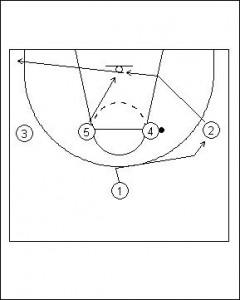
In this example of the Shuffle Offense the play starts in a 1-4 positioning.
Elbow receiver (4) looks to back cut pass or isolation opportunity.
The passer (1) fills the back cutter’s vacated position with a spaced sprint. This Space allows the player on the elbow (2) to drive or shoot.
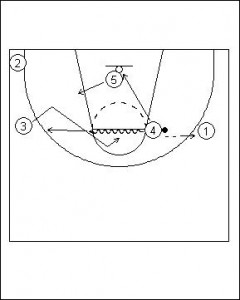
Continue with either:
Dribble handoff by Four (4) to 45 opposite the back cut, or Pass, basket cut to “circle” on-ball action.
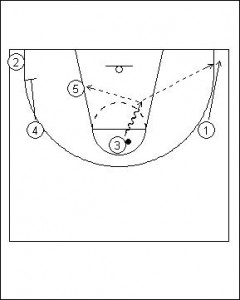
Hand-off receiver (3) looks to make the play (shot, drive, pass to where the help came from).
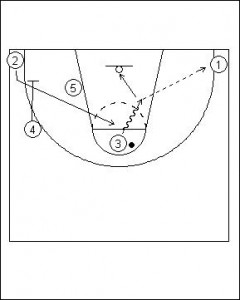
If the hand-off man (4) does not receive an immediate return pass from the hand-off receiver (3), set the down screen.
If the pass is to the perimeter on the drive (1), continue cut to the basket.
If corner receiver does not have the open shot, hard dribble out of the corner.
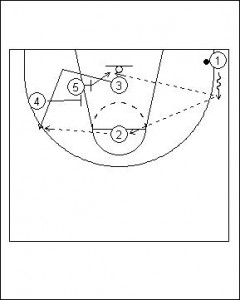
The basket cutter cuts off consecutive down screens.







Leave a Reply